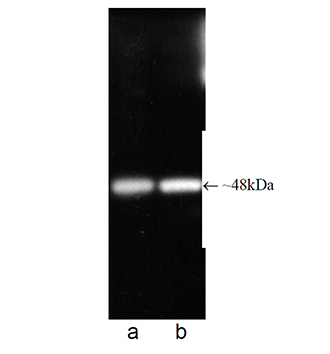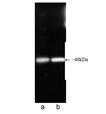Product Details
| Alternative Name: | 26S protease regulatory subunit 8, Proteasome 26S subunit ATPase 5, TRIP1, Thyroid hormone receptor-interacting protein 1, p45/SUG |
| |
| Clone: | p45-110 |
| |
| Host: | Mouse |
| |
| Isotype: | IgG2b |
| |
| Immunogen: | Recombinant human Rpt6 protein. |
| |
| UniProt ID: | P62195 |
| |
| Source: | Purified from hybridoma tissue culture supernatant. |
| |
| Species reactivity: | Human, Mouse, Rat
|
| |
| Specificity: | Recognizes the Rpt6/S subunit of the 19S regulator complex. |
| |
| Applications: | IHC, IP, WB
|
| |
| Application Notes: | Detects a band of ~48kDa by Western blot. |
| |
| Purity Detail: | Partially purified. |
| |
| Formulation: | Liquid. In PBS, pH 7.4, containing 10mM sodium azide. |
| |
| Shipping: | Blue Ice |
| |
| Long Term Storage: | -20°C |
| |
| Scientific Background: | The proteasome is widely recognised as the central enzyme of non-lysosomal protein degradation. It is responsible for intracellular protein turnover and it is also critically involved in many regulatory processes and, in higher eukaryotes, in antigen processing. The 26S proteasome is the key enzyme of the ubiquitin/ATP-dependent pathway of protein degradation. The catalytic core of this unusually large (2000kDa, 450Å in length) complex is formed by the 20S proteasome, a barrel shaped structure shown by electron microscopy to comprise of four rings each containing seven subunits. Based on sequence similarity, all fourteen 20S proteasomal subunit sequences may be classified into two groups, alpha and beta, each group having distinct structural and functional roles. The alpha-subunits comprise the outer rings and the beta-subunits the inner rings of the 20S proteasome. Observations of the eukaryotic proteasome and analysis of subunit sequences indicate that each ring contains seven different subunits (alpha7-beta7-beta7-alpha7) with a member of each sub-family represented in each particle. Each subunit is located in a unique position within the alpha- or beta-rings .
In addition to the 20S particle, the 26S complex contains over twenty additional proteins, ranging in molecular weight from 25 to 10kDa, located in a distinct complex called the ‘PA700 proteasome activator’ or the ‘19S complex’, and which determines substrate specificity and provides the multiple enzymatic functions necessary for proteolysis and viability. Systematic analysis of the sub-unit components have revealed at least six members to be ATPases belonging to a new family of ATPbinding proteins, together with a further fifteen sub-units that lack the capacity to bind ATP, isopeptidases and several other proteins thought to be responsible for the unfolding of a protein substrate prior to insertion into the proteolytic core of the 20S proteasome. |
| |
| Regulatory Status: | RUO - Research Use Only |
| |

Western blot analysis of Proteasome 19S ATPase subunit Rpt6, mAb (p45-110) (Prod. No. BML-PW9265). Antibody dilution 1:1000 (lane a) and 1:5000 (lane b) using ECL procedure.
Please mouse over
Product Literature References
Fish Oil Diet during Pre‐mating, Gestation, and Lactation in Adult Offspring Rats on Cancer Cachexia Prevention: S.C.P. Oliveira, et al.; Mol. Nutr. Food Res.
65, e2000863 (2021),
Abstract;
Exercise training prevents the perivascular adipose tissue-induced aortic dysfunction with metabolic syndrome: E. DeVallance, et al.; Redox Biol.
26, 101285 (2019),
Abstract;
Full Text
Cilostazol, a phosphodiesterase 3 inhibitor, activates proteasome-mediated proteolysis and attenuates tauopathy and cognitive decline: A.W. Schaler, et al.; Transl. Res.
193, 31 (2018),
Abstract;
Proteasome phosphorylation regulates cocaine-induced sensitization: F.R. Gonzales, et al.; Mol. Cell. Neurosci.
88, 62 (2018),
Abstract;
Detection of active proteasome structures in brain extracts: proteasome features of August rat brain with violations in monoamine metabolism: P.A. Erokhov, et al.; Oncotarget
8, 70695 (2017),
Abstract;
Full Text
Proteasome Activation by Small Molecules: Y. Leestemaker, et al.; Cell Chem. Biol.
24, 725 (2017),
Abstract;
Reduction of RPT6/S8 (a Proteasome component) and proteasome activity in the cortex is associated with cognitive impairment in Lewy body dementia: A. Alghamdi, et al.; J. Alzheimers Dis.
57, 37 (2017),
Abstract;
Long-term leucine supplementation aggravates prolonged strenuous exercise-induced cardiovascular changes in trained rats: G.B. Dos Santos, et al.; Exp. Physiol.
101, 811 (2016),
Abstract;
UBQLN2 Mediates Autophagy-Independent Protein Aggregate Clearance by the Proteasome: R. Hjerpe, et al.; Cell
166, 935 (2016),
Application(s): Western blot,
Abstract;
Full Text
Electron tomographic structure and protein composition of isolated rat cerebellar, hippocampal and cortical postsynaptic densities: M.M. Farley, et al.; Neuroscience
304, 286 (2015),
Application(s): Immunogold labeling ,
Abstract;
Skeletal muscle myotubes in severe obesity exhibit altered ubiquitin-proteasome and autophagic/lysosomal proteolytic flux: L.M. Bollinger, et al.; Obesity (Silver Spring)
23, 1185 (2015),
Application(s): Western Blot,
Abstract;
Full Text
Dynamics of the degradation of ubiquitinated proteins by proteasomes and autophagy: association with sequestosome 1/p62: N. Myeku, et al.; J. Biol. Chem.
286, 22426 (2011),
Application(s): Western blot,
Abstract;
Full Text












